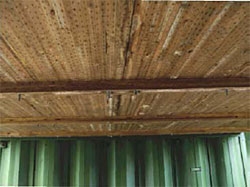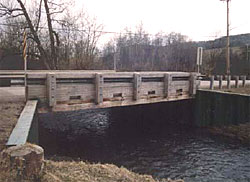Researchers
Terry Wipf
Wayne Klaiber
About the research
Longitudinal deck bridges have the potential to provide a cost effective short span alternative. In the early stages of the bridge concept development, very little data existed regarding the design of these bridge types, although some experimental laboratory testing had been performed. An analytical study was performed by Iowa State University to develop design recommendations suitable for the AASHTO Bridge Design Specifications. The analytical models, using finite element procedures, were validated using existing experimental data by others. The design recommendations focused on the load distribution of the deck panels based on common stiffener beam spacing, connectivity and geometry.
Researchers
Terry Wipf
Wayne Klaiber
About the research
In 1977 the Weyerhaeuser Company developed a short span glued laminated timber bridge that does not require any stringers. The bridge consists of glued laminated timber panels approximately 48 in. wide that are placed across the span in the direction of traffic. The panels are connected by stiffener beams that run in a transverse direction to the longitudinal axis of the panels and provide transverse live load distribution within the bridge. Typical maximum span lengths are 40 ft. This study focused on the structural behavior of deck panels and stiffener beams through laboratory experimental testing of a full scale bridge. In addition, finite element analytical models were developed to further study the bridge behavior. The experimental testing investigated various stiffener beam arrangements, two different connector types, various bridge widths and various truck load configurations. Deflection and strain data were collected.

